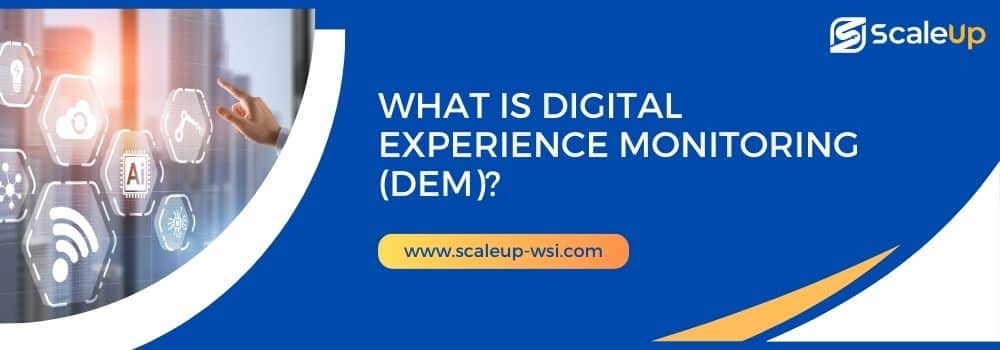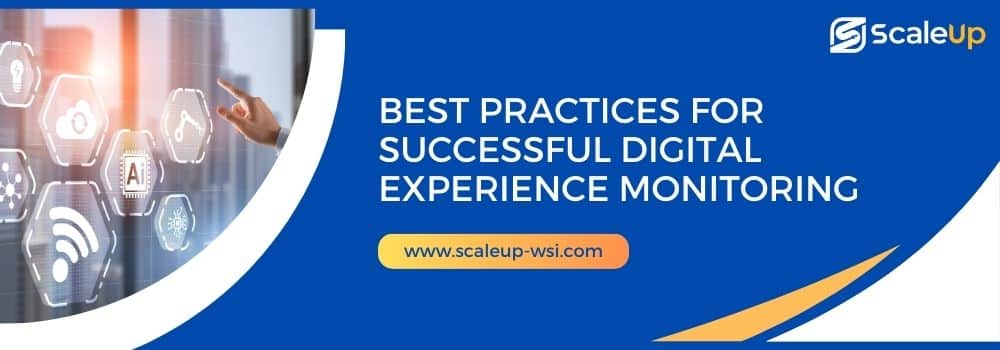Market Guide for Digital Experience Monitoring? Are you looking for ways to measure and demonstrate the success of your digital experience? With DEM, you can gain insights into user interactions with your website, app, or service and uncover any weak performance that could be compromising user satisfaction. Learn how to get started with our comprehensive guide!
Absolutely, you’re in the right place! Our all-inclusive guide is tailored to help you navigate the world of Digital Experience Monitoring (DEM) efficiently. With our expert tips, you’ll soon be able to monitor your online user interactions, pinpoint performance bottlenecks, and ensure optimal user satisfaction. So, buckle up for an insightful journey into enhancing your digital customer experiences!
In the following blog post, we’ll provide expert tips detailing the key elements required for successful implementation as well as the associated benefits on offer. Read on to learn more about DEM best practices and what tools need to be in place for optimal results.
Table of Contents
What is Digital Experience Monitoring (DEM)?

Digital Experience Monitoring (DEM) is an all-encompassing term for the proactive analysis and assessment of user interactions with digital services. With DEM, businesses gain insights into how their customers are interacting with their website, app, or service and identify any bottlenecks that may be compromising user experience.
- Get a clear understanding of customer behavior and preferences
- Identify user pain points quickly and efficiently
- Pinpoint areas for improvement in performance
- Track KPIs to monitor progress over time
- Receive actionable insights that will help you drive business growth
What are the Benefits of DEM for Businesses and Consumers like

For businesses, Digital Experience Monitoring (DEM) brings about a number of advantages. Firstly, customers can be tracked in real-time to understand and measure their satisfaction levels. This helps businesses identify any weak points in their digital experience that need improvement. Additionally, DEM provides actionable insights that can help direct the strategic decisions taken by the company for maximum growth potential.
Overall Experience
For consumers, DEM can play an essential role in improving the overall experience they have when interacting with a digital service. By uncovering user pain points and providing resources to better address them, businesses are able to ensure customers remain satisfied and loyal.
How to Choose a Digital Experience Monitoring Tool

When it comes to choosing the right Digital Experience Monitoring (DEM) tool, there is no one-size-fits-all solution. It’s important to do your research and consider the different options available in order to determine which option best suits your needs. Factors to consider when selecting a DEM tool include pricing, ease of use, customer support, level of automation, and metrics available.
- FullStory
- Hotjar
- Google Optimize
- Adobe Target
- Microsoft Clarity
- Appsee
- Heap Analytics
Common Features of DEM Tools

DEM tools typically offer powerful analytics capabilities to help businesses measure and optimize user experiences. Common features include heatmaps, session recordings, A/B testing, funnel analysis, form analytics, customer feedback surveys, and more. For example, Heap Analytics provides users with the ability to capture all user data without any extra coding efforts required.
Similarly, Hotjar enables companies to gain insights into user behavior with features such as session recordings and heatmaps. In short, DEM tools offer a comprehensive set of features to help businesses gain invaluable insights into customer behavior.
Tips for Implementing and Utilizing a DEM Tool

- Before implementing a DEM tool, it is important to create clear goals and objectives for the project.
- Focus on metrics that are most meaningful to your business and customers, such as customer satisfaction and retention rates.
- Utilize segmentation filters to gain further insights into user behavior by breaking down data into specific subsets of users.
- Use heatmaps and session recordings to gain a better understanding of how users interact with your product or website.
- Create A/B tests to determine the best design, content, or layout for a given page of your website or app.
- Analyze web forms to provide customers with an improved user experience by resolving any issues that may be causing users to abandon them.
- Utilize customer feedback surveys to better understand user attitudes and behaviors.
- Analyze customer reviews to pinpoint areas of improvement for your product or website.
- Use funnel analysis to identify any points in the conversion process where customers may be dropping off.
- Integrate DEM tools with other analytics platforms to gain a holistic view of customer behavior and performance.
Best Practices for Successful Digital Experience Monitoring

Digital Experience Monitoring (DEM) provides businesses with the data and insights needed to assess customer experience, track performance, identify opportunities for improvement, and optimize user experiences. To ensure successful implementation of a DEM tool, there are some best practices that should be followed:
- Establish clear objectives and goals from the outset so that data can be easily gathered and analyzed.
- Design a framework that captures the most relevant and useful data possible.
- Establish a baseline for user engagement and performance metrics to measure progress over time.
- Analyze customer behavior regularly to identify areas of opportunity for improvement in the user experience.
- Utilize segmentation filters to gain further insights into user behavior by breaking down data into more targeted groups.
- Use heatmaps and click maps to gain a deeper understanding of user interactions with a website, app, or service.
- Develop an effective action plan for responding to customer feedback and addressing weaknesses in the user experience.
- Monitor KPIs such as average session duration, page views per visit, bounce rate, conversion rate, and customer satisfaction to assess progress over time.
- Utilize A/B testing to compare the performance of different versions of a product or provide user feedback to inform design decisions.
- Leverage advanced technologies such as artificial intelligence and machine learning to identify potential problems in the customer journey, predict user behaviors and preferences, and provide real-time analytics on customer experience.
How to Make Sure You’re Getting the Most Out Of Your Investment in a DEM Tool

Digital Experience Monitoring (DEM) is an essential tool to gain insight into user interactions with your website, app, or service. To maximize its value, you need to set clear objectives, understand the data you’re collecting, use segmentation filters and heatmaps for deeper insights into user behavior, develop an effective action plan for responding to feedback, and monitor KPIs over time.
- Set clear objectives for collecting data.
- Understand the data you’re collecting to identify areas of improvement in the customer journey.
- Use segmentation filters and heatmaps to gain deeper insights into user behavior.
- Develop an action plan for responding to customer feedback.
- Monitor KPIs over time and use A/B testing to compare different product versions.
- Leverage advanced technologies such as AI and machine learning.
- Create an effective strategy to get the most out of your DEM investments and optimize customer experience success.
Conclusion
In the end, Digital Experience Monitoring is an invaluable tool that can help you gain valuable insights into user interactions with your website, app, or service. As such, it is important to create a strategy for getting the most out of your DEM investments and optimizing customer experience success. By setting clear objectives for collecting data, understanding the data you’re collecting, using segmentation filters and heatmaps to gain deeper insights into user behavior, developing an effective action plan for responding to customer feedback and monitoring KPIs over time, you can ensure that you are making the most out of your DEM investment.
Faqs
Q1. Gartner market guide for digital experience monitoring?
A1: Gartner’s Market Guide for Digital Experience Monitoring (DEM) provides an in-depth overview of the market, customer needs, key vendors, and technologies available to help enterprises gain insight into their digital experiences. The guide also offers best practices on how to use technology to ensure a successful outcome with improved customer satisfaction.
Q2. Digital experience monitoring vendors?
A2: There are a variety of vendors offering solutions to help monitor digital experiences. Some popular vendors include Adobe, Oracle, IBM, Google Analytics, and Salesforce. Each vendor offers unique features and functionality that can be tailored to meet the needs of each organization.
Q3. What technologies are used for digital experience monitoring?
A3: Digital Experience Monitoring technologies can include a variety of tools such as heat maps, segmentation filters, and analytics dashboards. These tools provide valuable insight into user behavior, enabling you to identify areas for improvement and take action on customer feedback. Additionally, these technologies can be used to track key performance indicators (KPIs) over time to ensure that any changes made are having a positive effect on user engagement and satisfaction.
Q4. Digital experience monitoring Gartner magic quadrant?
A4: Gartner’s Magic Quadrant for Digital Experience Monitoring provides a comparison of the leading solutions in this space. It takes into account factors such as customer satisfaction, product features, and market presence to provide an overview of the most popular vendors and technologies available. This can help organizations select a solution that meets their specific needs and budget.
Q5. Gartner digital experience monitoring?
A5: Gartner’s Digital Experience Monitoring (DEM) Magic Quadrant provides an overview of the leading solutions in this space. It takes into account factors such as customer satisfaction, product features, and market presence to provide an overview of the most popular vendors and technologies available. This can help organizations select a solution that meets their specific needs and budget.
Q6. Digital experience monitoring (dem) marketplace?
A6: The Digital Experience Monitoring (DEM) marketplace provides organizations with a variety of solutions to choose from. It is important to consider factors such as customer satisfaction, product features, and market presence when selecting a solution that meets your needs and budget. Additionally, it can be helpful to read reviews and user feedback on each vendor’s technology before making a decision.
